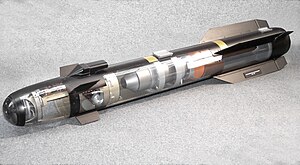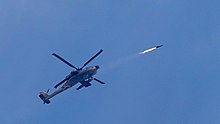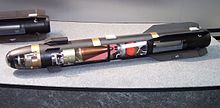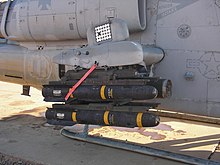begin partial quote from:
The MQ-9 is fitted with six stores pylons. The inner stores pylons can carry a maximum of 1,500 pounds (680 kg) each and allow carriage of external fuel tanks. The mid-wing stores pylons can carry a maximum of 600 pounds (270 kg) each, while the outer stores pylons can carry a maximum of 200 pounds (91 kg) each. An MQ-9 with two 1,000 pounds (450 kg) external fuel tanks and 1,000 pounds (450 kg) of munitions has an endurance of 42 hours.[14] The Reaper has an endurance of 14 hours when fully loaded with munitions.[4]
The MQ-9 carries a variety of weapons including the GBU-12 Paveway II laser-guided bomb, the AGM-114 Hellfire II air-to-ground missiles, the AIM-9 Sidewinder,[15] and the GBU-38 Joint Direct Attack Munition (JDAM). Tests are underway to allow for the addition of the AIM-92 Stinger air-to-air missile.[citation needed]
By October 2007, the USAF owned nine Reapers,[16] and by December 2010 had 57 with plans to buy another 272, for a total of 329 Reapers.[17] Critics have stated that the USAF's insistence on qualified pilots flying RPVs is a bottleneck to expanding deployment. USAF Major General William Rew stated on 5 August 2008, "For the way we fly them right now"—fully integrated into air operations and often flying missions alongside manned aircraft—"we want pilots to fly them."[18] This reportedly has exacerbated losses of USAF aircraft in comparison with US Army operations.[19] In March 2011, U.S. Department of Defense Secretary Robert Gates stated that, while manned aircraft are needed, the USAF must recognize "the enormous strategic and cultural implications of the vast expansion in remotely piloted vehicles..." and stated that as the service buys manned fighters and bombers, it must give equal weight to unmanned drones and "the service's important role in the cyber and space domains."[7]
Here is some more information regarding what ordnance that an MQ-9 can carry:
GBU-12 Paveway II
| GBU-12 Paveway II | |
|---|---|
 GBU-12 Paveway II | |
| Type | Laser guided bomb |
| Place of origin | United States |
| Production history | |
| Manufacturer | Lockheed Martin |
| Unit cost | US $21,896[1] |
| Specifications | |
| Mass | 230 kg (510 lb) |
| Length | 3.27 m (10.7 ft) |
| Diameter | 273 mm (10.7 in) |
| Effective firing range | 14.8 km (9.2 mi) |
The GBU-12 Paveway II is an American aerial laser-guided bomb, based on the Mk 82 500-pound (227 kg) general-purpose bomb, but with the addition of a nose-mounted laser seeker and fins for guidance. A member of the Paveway series of weapons, Paveway II entered into service c. 1976. It is currently in service with the U.S. Air Force, U.S. Navy, U.S. Marine Corps, and various other air forces.
Development and deployment
The development of the GBU-12 traces back to the Vietnam War. The U.S. Air Force wanted a greater variety of laser-guided bombs, especially a lighter and more maneuverable one to be able to hit moving targets on the Ho Chi Minh trail.[2] Earlier designs of guided bombs such as the BOLT-117 were quickly superseded by the Paveway series of add-on kits for conventional bombs.
GBU-12 bombs (along with the balance of the Paveway series) are produced by defense contractors Lockheed Martin and Raytheon. Raytheon began production after purchasing the product line from Texas Instruments. Lockheed Martin was awarded a contract to compete with Raytheon when there was a break in production caused by transferring manufacturing out of Texas. "Paveway II" refers specifically to the guidance kit, rather than to the weapon itself. See also GBU-16 Paveway II, where the same guidance unit is fitted to a Mk 83 1,000-lb bomb (454 kg).
The GBU-12 has been used in numerous conflicts such as the Gulf War where the U.S. Air Force reports an 88% hit rate.[2] It is among the most commonly used guided munitions, and as such is able to be dropped from a very wide variety of aircraft, such as the B-52, A-10, F-15E, and F/A-18.[3]
Guidance
The US Department of Defense has upgraded GBU-12 production versions to include GPS guidance modes.[4] Lockheed Martin is the sole source for US Navy purchases of this version. Raytheon sells upgraded GBU-12s to the US Government and 23 other nations.[4] Laser-guided bombs are often labeled "smart bombs" because they are able to follow a non-ballistic trajectory when laser designation of the intended target is undertaken. According to Raytheon's fact sheet for the Paveway 2, 99 deliveries of guided munitions will yield a circular error probable (CEP) of only 3.6 feet (1.1 m), versus a CEP of 310 feet (94 m) for 99 unguided bombs dropped under similar conditions.
Paveway II laser-guided bombs use what is known as "bang bang" guidance. This means the bomb's fins deflect fully, rather than proportionally when it is attempting to guide to the laser spot. For example, if it sees the laser spot and determines that it should make a change it deflects its fins until it has over-corrected and then it deflects back the opposite direction, creating a sinusoidal type of flight path. This type of guidance may be less efficient at times, however is more cost-effective and allows the use of simpler electronics in the guidance system.
References
- "Lockheed precision-guided munitions tests successful". GPS World. North Coast Media LLC. Retrieved 11 April 2021.
External links
- Raytheon's official Paveway fact page
- Globalsecurity.org Paveway fact page
- Lockheed Martin Paveway fact page
begin quote from:
https://en.wikipedia.org/wiki/AGM-114_Hellfire
AGM-114 Hellfire
| AGM-114 Hellfire | |
|---|---|
 A model of Longbow Hellfire's components | |
| Type | Air-to-surface and surface-to-surface missile |
| Place of origin | United States |
| Service history | |
| In service | 1984–present |
| Wars | War on Terror 1991 Gulf War Russian Invasion of Ukraine |
| Production history | |
| Manufacturer | Lockheed Martin, Boeing (prior second source), and Northrop Grumman (seeker only for AGM-114L Longbow Hellfire) |
| Unit cost | US$150,000[1]
(FY 2021) US$117,000 (FY2017)[2] |
| Produced | 1974–present |
| Specifications | |
| Mass | 100–108 lb (45–49 kg)[3] |
| Length | 64 in (1.6 m) |
| Diameter | 7 in (180 mm) |
| Wingspan | 13 in (0.33 m) |
| Warhead | |
| Engine | Thiokol TX-657[4][5] Solid-fuel rocket |
| Propellant | APC/HTPB |
Operational range | 550 to 12,030 yd (0.5 to 11 km) |
| Maximum speed | Mach 1.3 (995 mph; 1,601 km/h) |
Guidance system | |
Launch platform | Rotary- and fixed-wing aircraft, unmanned combat aerial vehicles, tripods, ships, ground vehicles |
The AGM-114 Hellfire is an American air-to-ground missile (AGM) first developed for anti-armor use,[6] later developed for precision[7] drone strikes against other target types, especially high-value targets.[8] It was originally developed under the name Heliborne laser, fire-and-forget missile, which led to the colloquial name "Hellfire" ultimately becoming the missile's formal name.[9] It has a multi-mission, multi-target precision-strike ability and can be launched from multiple air, sea, and ground platforms, including the MQ-1 Predator and MQ-9 Reaper. The Hellfire missile is the primary 100-pound (45 kg) class air-to-ground precision weapon for the armed forces of the United States and many other nations. It has also been fielded on surface platforms in the surface-to-surface and surface-to-air roles.[10]
Description
Most variants are laser-guided, with one variant, the AGM-114L "Longbow Hellfire", being radar-guided.[11][12] Laser guidance can be provided either from the launcher, such as the nose-mounted opto-electronics of the AH-64 Apache attack helicopter, other airborne target designators or from ground-based observers, the latter two options allowing the launcher to break line of sight with the target and seek cover.[13]
The development of the Hellfire Missile System began in 1974 with the United States Army requirement for a "tank-buster", launched from helicopters to defeat armored fighting vehicles.[14][15][unreliable source?]
The Hellfire II, developed in the early 1990s is a modular missile system with several variants, and entered service with the U.S. Army in 1996.[16] Hellfire II's semi-active laser variants—AGM-114K high-explosive anti-tank (HEAT), AGM-114KII with external blast fragmentation sleeve, AGM-114M (blast fragmentation), and AGM-114N metal augmented charge (MAC)—achieve pinpoint accuracy by homing in on a reflected laser beam aimed at the target. The General Atomics MQ-1 Predator and MQ-9 Reaper unmanned combat aerial vehicles (UCAVs) carry the Hellfire II, but the most common platform is the AH-1Z Viper helicopter gunship, which can carry up to 16 of them. The AGM-114L, or Longbow Hellfire, is a fire-and-forget weapon: equipped with a millimeter-wave (MMW) active radar homing, it requires no further guidance after launch—even being able to lock on to its target after launch[17]—and can hit its target without the launcher or other friendly unit being in line of sight of the target. It also works in adverse weather and battlefield obscurants, such as smoke and fog, which can mask the position of a target or prevent a designating laser from forming a detectable reflection. Each Hellfire weighs 47 kilograms (104 lb), including the 9 kilograms (20 lb) warhead, and has a range of 7.1–11 kilometres (4.4–6.8 mi) depending on trajectory.[18]
The AGM-114R "Romeo" Hellfire II entered service in late 2012. It uses a semi-active laser homing guidance system and a K-charge multipurpose warhead[19][20] to engage targets that formerly needed multiple Hellfire variants. It will replace AGM-114K, M, N, and P variants in U.S. service.[21]
In October 2012, the U.S. ordered 24,000 Hellfire II missiles, for both the U.S. armed forces and foreign customers.[22]
A possible new JCM successor called the Joint Air to Ground Missile (JAGM) is under consideration. Due to budget reductions, JAGM development was separated into increments, with increment 1 focusing on adding a millimeter-wave radar to the Hellfire-R to give it a dual-mode seeker, enabling it to track moving targets in bad weather.[23][24]
Operational history
In 2009, the British Ministry of Defence (MoD) acknowledged that Army Air Corps (AAC) AgustaWestland Apaches had used AGM-114 Hellfire missiles against Taliban forces in Afghanistan. The MoD stated that 20 missiles were used in 2008 and a further 20 in 2009. In the British Parliament, Liberal Democrat politician Nick Harvey argued that the "Parliament must be reassured these are a weapon of last resort."[26]
AGM-114 Hellfire missiles were used to kill Hamas leader Ahmed Yassin by the Israeli Air Force (IAF) in 2004,[27][28] and by the US military to kill American-born Islamic cleric Anwar al-Awlaki in Yemen in 2011,[29] Al-Qaeda operative Abu Yahya al-Libi in Pakistan in 2012, al-Shabaab militant Mukhtar Abu Zubair in Somalia in 2014,[30] and British ISIL executioner Mohammed Emwazi (also known as "Jihadi John") in Syria in 2015.[31] They were also used in the assassination of Qasem Soleimani as well as the killing of Ayman al-Zawahiri.[32]
The AGM-114 has occasionally been used as an air-to-air missile. The first operational air-to-air kill with a Hellfire took place on 24 May 2001, after a civilian Cessna 152 aircraft entered Israeli airspace from Lebanon, with unknown intentions and refusing to answer or comply with ATC repeated warnings to turn back. An Israeli Air Force AH-64A Apache helicopter fired on the Cessna, resulting in its complete disintegration.[33][34] The second operational air-to-air kill with a Hellfire occurred on 10 February 2018, after an Iranian UAV entered Israeli airspace from Syria. An Israeli Air Force AH-64 launched a Hellfire missile at the UAV, successfully destroying it.[35][third-party source needed]
In January 2016 The Wall Street Journal reported that one training missile without a warhead was accidentally shipped to Cuba in 2014 after a training mission in Europe;[36] it was later returned.[37] A US official said that this was an inert "dummy" version of the Lockheed system stripped of its warhead, fuse, guidance equipment and motor, known as a "Captive Air Training Missile".[38][39]
Variants
This section needs additional citations for verification. (January 2016) |
- AGM-114A
- [40]
- Produced: 1982–1992
- Target: Armored vehicles
- Range: 8,000 m (8,700 yd)
- Guidance:
- Semi-active laser homing (SALH)
- Non-programmable. Analogue autopilot.
- Warhead: 8 kg (18 lb) shaped charge HEAT. Unable to penetrate reactive armor.
- Length: 163 cm (64 in)
- Weight: 45 kg (99 lb)
- AGM-114B/C
-
- Produced: 1982–1992
- Target: Armored vehicles, ship-borne targets
- Range: 8,000 m (8,700 yd)
- Guidance:
- Semi-active laser homing (SALH)
- Non-programmable
- Analogue autopilot
- Warhead: 8 kg (18 lb) shaped charge HEAT. Unable to penetrate reactive armor.
- Length: 163 cm (64 in)
- Weight: 45 kg (99 lb)
- AGM-114F/FA Interim Hellfire
-
- Produced: 1991[41]–1994[42]
- Target: Armored vehicles
- Range: 8,000 m (8,700 yd)
- Guidance:
- Semi-active laser homing (SALH)
- Non-programmable
- Analogue autopilot
- Warhead: 8 kg (18 lb) shaped charge HEAT. Tandem-charge, can penetrate reactive armor.
- Length: 163 cm (64 in)
- Weight: 45 kg (99 lb)
- AGM-114K/K2/K2A Hellfire II
-
- Produced: since 1993–2018[43]
- Target: All armored targets
- Range: 11,000 m (12,000 yd)
- Guidance:
- Semi-active laser homing with electro-optical countermeasures hardening
- Digital autopilot & electronics improvements allow target reacquisition after lost laser lock
- Warhead: 9 kg (20 lb) tandem shaped charge HEAT
- Length: 163 cm (64 in)
- Weight: 45 kg (99 lb)
- K-2 adds insensitive munitions (IM)
- K-2A adds blast-fragmentation sleeve
- AGM-114L Hellfire LongBow
-
- Produced: 1995–2005, 2016–[43][44]
- Target: All armored targets
- Range: 8,000 m (8,700 yd)
- Guidance:
- Fire and forget millimeter-wave (MMW) radar seeker coupled with inertial guidance
- Homing capability in adverse weather and the presence of battlefield obscurants
- Programmable fusing and guidance
- Warhead: 9 kg (20 lb) tandem shaped charge high-explosive anti-tank (HEAT) insensitive munitions (IM) warhead
- Length: 180 cm (71 in)
- Weight: 49 kg (108 lb)
- L-7/8A Counter-UAS/counter-littoral variants with proximity fuze and blast-fragmentation sleeve[44]
- AGM-114M Hellfire II (Blast Frag)
-
- Produced: 1998–2010
- Target: Bunkers, light vehicles, urban (soft) targets and caves
- Range: 11,000 m (12,000 yd)
- Guidance:
- Semi-active laser homing
- Delayed and programmable fusing in for hardened targets
- Warhead: Blast fragmentation/incendiary
- Weight: 49 kg (108 lb)
- Length: 180 cm (71 in)
- AGM-114N Hellfire (MAC)
- [45]
- Hellfire II missile exposed through a transparent casing, showing laser homing guidance system in front, copper cone shaped charge explosive in middle, propulsion in the rear
- Produced: 2003–2018[43]
- Target: Buildings, soft-skinned targets, ship-borne targets
- Range: 11,000 m (12,000 yd)
- Guidance:
- Semi-active laser homing
- Millimeter-wave radar seeker
- Warhead: Metal augmented charge (thermobaric), sustained pressure wave with delayed fuse capability
- Weight: 48 kg (106 lb)
- Speed: Mach 1.3 (1,600 km/h)
- Diameter: 180 mm (7.1 in)
- Wingspan: 0.33 m (13 in)
- Length: 1.63 m (5 ft 4 in)
- AGM-114P/P+ Hellfire II (For UAS)
-
- Produced: 2003–2012
- Target: All surface targets
- Range: 11,000 m (12,000 yd)
- Guidance:
- Semi-active laser homing
- Delayed and programmable fusing in for hardened targets
- Warhead: Shaped Charge or Blast Fragmentation
- Weight: 49 kg (108 lb)
- Length: 180 cm (71 in)
- Designed for UAV altitudes
- P-2A adds steel fragmentation sleeve
- P-2B adds tantalum fragmentation sleeve
- P+ Adds enhanced inertial measurement unit (IMU) and software support, many customizations for varying battlefields.
- AGM-114R Hellfire II (Hellfire Romeo)
- [46]
- Produced: since 2012
- Target: All targets
- Range: 11,000 m (12,000 yd)
- Guidance:
- Semi-active laser homing
- Warhead: Multi-function warhead, reduced net explosive weight for low collateral damage (R-9E and R-9H).
- Weight: 49 kg (108 lb)
- Speed: Mach 1.3
- Length: 180 cm (5 ft 11 in)[40]
- Unit Cost: $99,600 (all-up round, 2015 USD)[47]
- M36 Captive Flight Training Missile
- The M36 is an inert device used for training in the handling of the Hellfire. It includes an operational laser seeker.[48]
- AGM-114R9X
- The Hellfire R9X is a Hellfire variant with a kinetic warhead with pop-out blades instead of explosives, used against specific human targets. Its lethality is due to 45 kg (99 lb) of dense material with six blades flying at high speed, to crush and cut the targeted person[49]— the R9X has also been referred to as the 'Ninja Missile'[50] and 'Flying Ginsu'.[49] It is intended to reduce collateral damage when targeting specific people.[51] Deployed in secret in 2017, its existence has been public since 2019. This variant was used in the killing in 2017 of Abu Khayr al-Masri, a member of Al-Qaeda's leadership, and in 2019 of Jamal Ahmad Mohammad Al Badawi, accused mastermind of the 2000 USS Cole bombing.[52][53] The weapon has also been used in Syria,[54] and in Afghanistan against a Taliban commander.[55][56] It was used twice in 2020 against senior al-Qaeda leaders in Syria; in September 2020 US officials estimated that it had been used in combat around six times.[57][58][59][60][61]
- Hellfire missiles fired by a Reaper drone[62] were used on 31 July 2022 to kill Ayman al-Zawahiri,[7] the leader of Al-Qaeda, who had formerly been involved in planning the 9/11 and other attacks on US targets. It was reported that the missile hit him on a balcony, causing minimal collateral damage. Reports stress that avoiding other casualties was a priority for the mission, following drone attacks that killed several uninvolved people, attracting much criticism. It is widely thought that the Hellfires were the R9X variant, but a United States Special Operations Command spokesman declined to comment, while confirming that the R9X was "in US Special Operations Command's munitions inventory".[63][64]
Launch vehicles and systems
Manned helicopters
Fixed-wing aircraft
- Beechcraft Super King Air[66]
- Cessna AC-208 Combat Caravan[67]
- KC-130J Harvest HAWK[68]
- IOMAX Archangel[69][70]
- AC-130W[71]
- MQ-1 Predator
- MQ-1C Gray Eagle
- MQ-9 Reaper
Vessels
- Super Dvora Mk III-class patrol boat, Israel[72]
- Freedom-class littoral combat ship
- Independence-class littoral combat ship
Ground vehicles
Experimental platforms
The system has been tested for use on the Humvee and the Improved TOW Vehicle (ITV). Test shots have also been fired from a C-130 Hercules. Sweden and Norway use the Hellfire for coastal defense and have conducted tests with Hellfire launchers mounted on the Combat Boat 90 coastal assault boat.[73]
The US Navy was evaluating the missile for use on the Freedom-class littoral combat ship and Independence-class littoral combat ship from 2014.[74] The missile was successfully fired from a LCS in early 2017[75] This system is set to deploy by late 2019.[76]
In 2016 the Longbow Hellfire was tested by the US Army using a 15-tube Multi-Mission Launcher mounted on a Family of Medium Tactical Vehicles (FMTV) truck. The MML is an Army-developed weapon system capable of deploying both surface-to-surface and surface-to-air missiles.[77]
Operators
The following nations use the Hellfire:[78]
 Australia
Australia Croatia
Croatia Egypt
Egypt France
France Greece[79]
Greece[79] India
India Indonesia
Indonesia Iraq
Iraq Israel
Israel Italy
Italy Jordan
Jordan Morocco
Morocco Japan
Japan Kuwait
Kuwait Lebanon[80]
Lebanon[80] Netherlands
Netherlands Norway
Norway Pakistan
Pakistan Qatar
Qatar South Korea
South Korea Saudi Arabia
Saudi Arabia Singapore
Singapore Spain
Spain Sweden
Sweden Taiwan (Republic of China)
Taiwan (Republic of China) Tunisia[81]
Tunisia[81] Turkey
Turkey Ukraine[82]
Ukraine[82] United Arab Emirates
United Arab Emirates United Kingdom
United Kingdom United States
United States
See also
References
The AGM-114B also introduced the Thiokol TX-657 (M120E1) reduced-smoke rocket motor.
The component that ... propels the Hellfire is the Thiokol TX-657.
- "Sweden sends anti-ship and anti-tank missiles to Ukraine". The Local. 22 June 2022. Retrieved 5 August 2022.
External links
- AGM-114 Hellfire Archived 8 September 2016 at the Wayback Machine—Federation of American Scientists (FAS)
- HELLFIRE II Missile—Lockheed Martin
- LONGBOW FCR and LONGBOW HELLFIRE Missile—Lockheed Martin
- Designation Systems
- Global Security
- Archived copy of Navy Fact File
- Janes.com
- Hellfire Detailed Description and Images Archived 23 February 2008 at the Wayback Machine
- Air-to-surface missiles of the United States
- Anti-tank guided missiles of the United States
- Anti-tank guided missiles of the Cold War
- Thermobaric weapons
- Military equipment introduced in the 1980s
- Fire-and-forget weapons
- Lockheed Martin
end quotes:
Note: Though there is more ordnance that an MQ-9 can carry I'm leaving it here for now but I might do more research over time and add more here later.










No comments:
Post a Comment